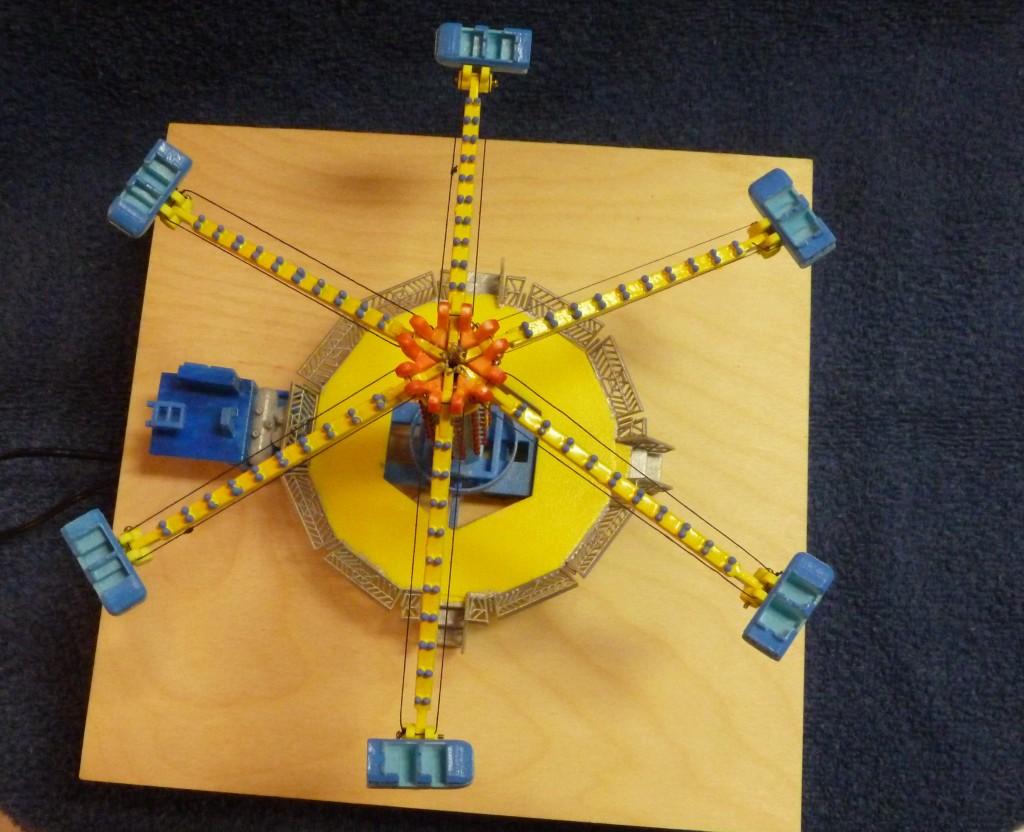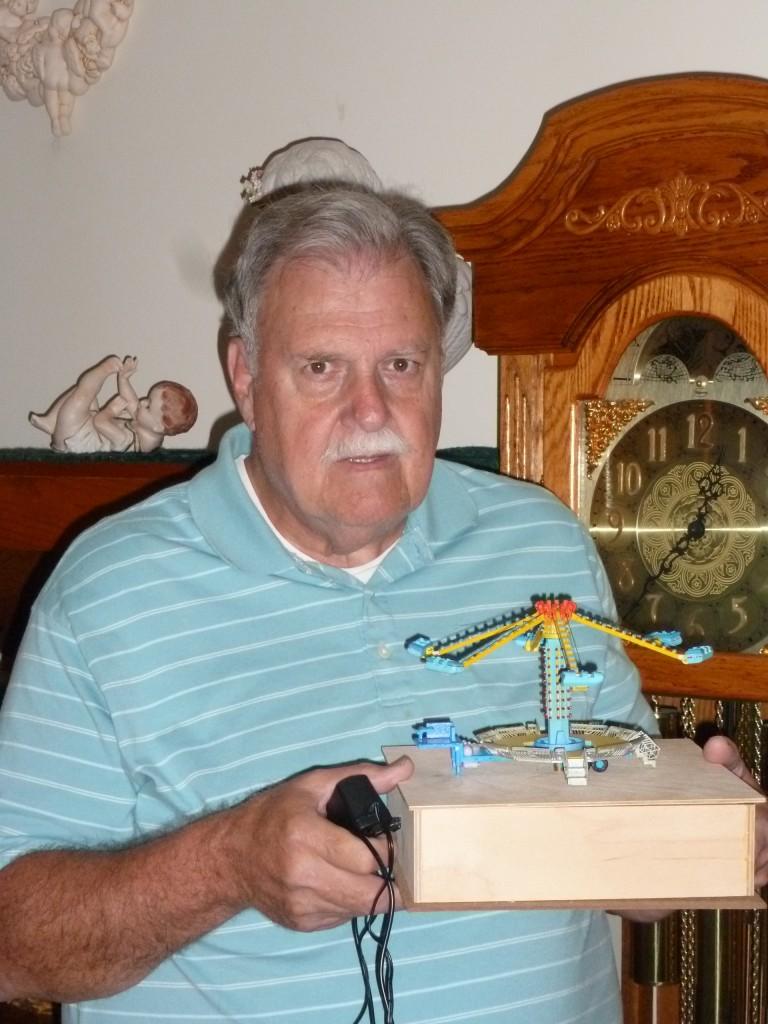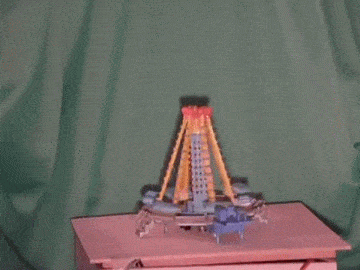 66-year-old Richard Schmiedecke of Winter Garden, Florida has always loved carnival rides, and grew to appreciate them while he worked for one week out of the year at a carnival near his then-home in Pittsburgh, PA. He graduated from Penn State in 1972 and had a successful career beginning as an electrical designer right out of college for Procter & Gamble. His retirement in 2001 gave him more time to pursue childhood passions — like carnivals. He likes the rides so much that he regularly photographs them for CARNIVAL Magazine. He also decided to design and 3D print his own operable carnival ride model based on a Paradise Amusements ride he first saw in Apopka, Florida about 5 years ago.
66-year-old Richard Schmiedecke of Winter Garden, Florida has always loved carnival rides, and grew to appreciate them while he worked for one week out of the year at a carnival near his then-home in Pittsburgh, PA. He graduated from Penn State in 1972 and had a successful career beginning as an electrical designer right out of college for Procter & Gamble. His retirement in 2001 gave him more time to pursue childhood passions — like carnivals. He likes the rides so much that he regularly photographs them for CARNIVAL Magazine. He also decided to design and 3D print his own operable carnival ride model based on a Paradise Amusements ride he first saw in Apopka, Florida about 5 years ago.
Schmiedecke was given permission to climb the ride and photograph it for its dimensions, and that is how this project was first born. The initial prototypes of the ride were made using the build/cast system using plastic: he ended up making an entirely static model of the ride this way. Then he decided he wanted one that moved, operating just like the ride does in real life.
 But this was frustrating as he could not get the parts to run as a functioning model system. It was at this point of frustration, while he consulted with people in the carnival industry who know much more about rides, that he graduated to 3D design. While Schmiedecke reports a background drawing in AutoCAD, he also reports a rocky start with 3D design software. But from the looks of his completed and operable carnival ride, he accepted the design challenge and overcame the bumpy start.
But this was frustrating as he could not get the parts to run as a functioning model system. It was at this point of frustration, while he consulted with people in the carnival industry who know much more about rides, that he graduated to 3D design. While Schmiedecke reports a background drawing in AutoCAD, he also reports a rocky start with 3D design software. But from the looks of his completed and operable carnival ride, he accepted the design challenge and overcame the bumpy start.
How does the ride work? Schmiedecke explained to 3DPrint.com that the ride’s model has a servo “like the ones used on radio control models” and a DC drive motor/gearbox turn the cars while the servo drives the sweep arms up and down. Like so many other 3D printed models, the electronics proved to be the most complicated part.
 The model’s control system is made up of an Italian Arduino Uno micro computer and an H Bridge that is used to supply power to the
The model’s control system is made up of an Italian Arduino Uno micro computer and an H Bridge that is used to supply power to the
DC motor. The micro computer runs a program that tells the DC motor to turn slowly, then increase to its running speed. At this point, the sweep arms raise to about half of full height and briefly remain there. The sweeps start to bounce, increasing in height until full height is reached while continuing to bounce the full swing for a while. Finally, the bounce decreases, the arms and cars reach the original position, and the turning motion slows to a full stop.
As for the printing aspect of the project, the model featured on the below YouTube video was 3D printed by Shapeways without supports, but Schmiedecke has his own 3D printing setup as well. He explained some of his own observations about printing the carnival ride to 3Dprint.com:
“I purchased a [Da Vinci] printer about a year ago and have learned a lot using it. Its capability is fantastic but limited. It needs to generate supports as it builds which requires a lot of hand work be done with the parts after printing to make them useable. It is an iterative process for sure. The final model has about 25 printed parts, plus a few dozen other things like micro bolts and brass tubes for the drive shafts.”
All of this long time passion for carnival rides, and this new interest in 3D printing, has led Schmiedecke to launch his own company — Carnivalkits, LLC. This business is in its start up phase, but the goal is to make kits available to collectors who share his same love of the carnival life. You can contact the company at carnivalkits@aol.com and check out the shop on Shapeways.
Let us know what you think in the Carnivalkits forum thread over at 3DPB.com. Check out the video below.
Subscribe to Our Email Newsletter
Stay up-to-date on all the latest news from the 3D printing industry and receive information and offers from third party vendors.
You May Also Like
3D Printing Financials: Fathom Struggles in Financial Quicksand During Critical Transition
Facing a year of key transitions and financial pressures, Fathom (Nasdaq: FTHM) has filed its annual report for 2023 with the U.S. Securities and Exchange Commission (SEC). The document outlines...
Latest Earnings Overview for Australian 3D Printing Firms Titomic and AML3D
Australian 3D printing manufacturing firms Titomic (ASX: TTT) and AML3D (ASX: AL3) reported their financial results for the period from July to December 2023, marking the first half of their...
3D Printing Webinar and Event Roundup: April 7, 2024
Webinars and events in the 3D printing industry are picking back up this week! Sea-Air-Space is coming to Maryland, and SAE International is sponsoring a 3D Systems webinar about 3D...
3D Printing Financials: Unpacking Farsoon and BLT’s 2023 Performance
In the Chinese 3D printing industry, two companies, Farsoon (SHA: 688433) and Bright Laser Technologies, or BLT (SHA: 688333), have recently unveiled their full-year earnings for 2023. Farsoon reported increases...
































